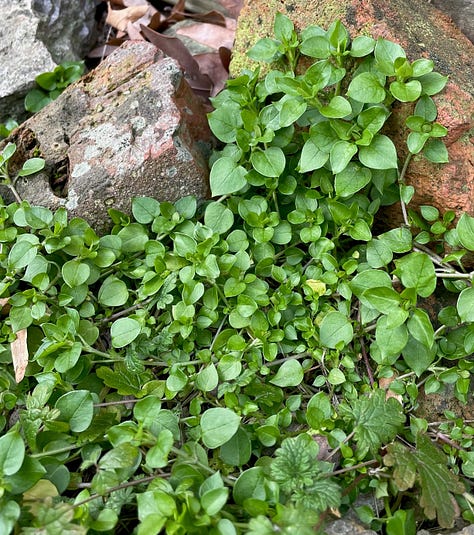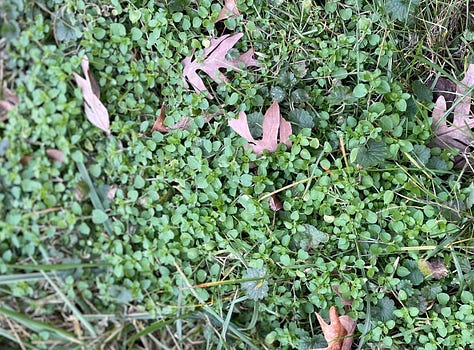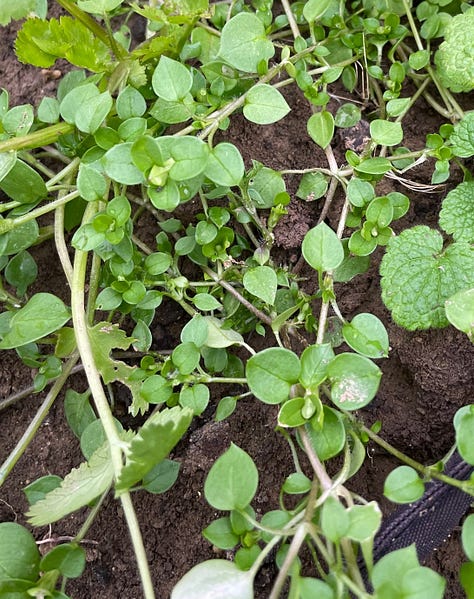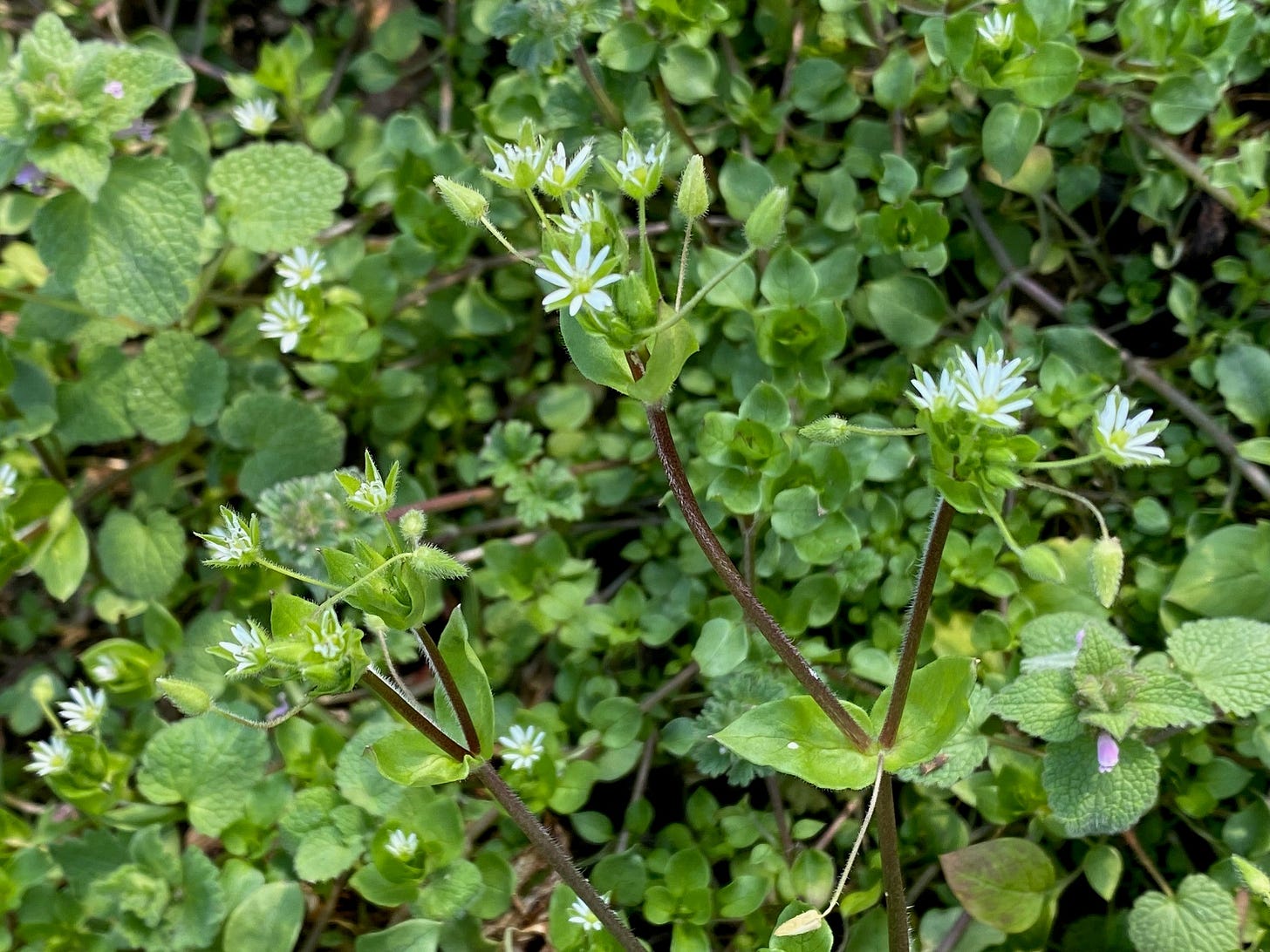Chickweed 1
Free food :-)
From the pink or carnation family, Caryophyllaceae, common chickweed (Stellaria media) is both a late fall and early spring salad weed, full of nutritional and demulcent goodies. It crops up before grass turns green, sits and looks at you for awhile, then numerous stalks shoot out of the base and vine like crazy along the ground as soon as the sun warms things up during the day. The succulent (juicy) leaves form oppositely on the stem on short stalks (petioles) which are hairy. The stem itself has a line of hairs that forms a slow spiral around it, changing positions from node to node. If you pull apart the stem, you can see a stretchy core 'fiber' surrounded by a sort of outer sleeve. The leaves are a slightly cupped oval shape, with smooth edges, pointed at one end, with branching veins coming from a central vein (pinnate pattern). White flowers emerge from hairy buds, with five radially arranged petals (daisy style), about a half centimeter across. But the cleft in each petal is so deep that you'd swear there are 10 petals when you first look at it. Those hairy buds have five green segments which remain as the sepals below the petals of the flower after it opens.
There are numerous related plants, and those listed below are likely to be found in the midwest region. Many of these are somewhat edible or medicinal, but the common chickweed is by far the star of them all.
Here are good pics of mouse-ear chickweed (Cerastium vulgatum) which is in another genus. It has similar flowers, but the leaves are hairy, more oblong, less succulent, and lack stalks (petioles).
Sticky chickweed (Cerastium glomeratum) is another lookalike, which has sticky, hairy, grayish looking leaves that lack petioles.
Star Chickweed (Stellaria pubera) grows in more wooded areas. It has hairy oblong leaves, doesn't vine out so profusely, and the blooms are much bigger, more than a centimeter wide. Here's Angelyn's page which absolutely rocks as a means to ID and distinguish between Common Chickweed and Star Chickweed. Expect many more trips to her website for plant identification, and tell your friends about it.
Bog Chickweed, Stellaria alsine can be found in well watered areas, beside creeks and in woodlands.
Common Chickweed is a juicy plant which has considerable weight when you harvest it, but dries to nearly to a fluff of nothing in the summer sun. It's best used fresh, which is why we're lucky that it appears both in the spring and fall in this midwest region. If you dry the plant, use it right away. It loses a lot of its potential quickly. The entire plant above the ground (aerial part) is useful, and exceptionally safe as food and medicine. Leave a little to make flowers and seeds when you harvest, so that it returns.
What are you going to do with chickweed now that you can find it?
First of all, Chickweed, with is mildly grassy flavor, is edible as a salad green. Like many salad greens, including some that you would find in your grocery store, such as chard, chickweed has a fair amount of oxalic acid. This is only one of the reasons to consume the raw herb in normal human proportions. The saponins, mucilage and coumarins will really get your attention too, if chickweed becomes your full diet. When any oxalic acid containing herb is boiled, a large portion of that substance is extracted into the water, but of course some of the good nutrition goes with it. Cooked chickweed becomes a bit more spinach-like in character.
Some people get really enthused about a particular "superfood" and want to eat bales of it, or gallons of the juice. This is NOT the Weedom Way. Eating a variety of food is much better for good health. It's an instinct that many other animals have acquired which prevents sickness or death by overdosing. A future article here will be a compendium of fun facts about common and staple foods of the human diet which can be quite harmful when eaten in bovine proportions. Humanity has learned much from famines and food fetishes.
Chickweed made it's way into historical King's American Dispensatory as a poultice for intractable skin ulcers, for opthalmia, as an ointment for erysipelas (Strep A skin infections) and other types of skin ulcers, and as a tincture for certain pains attributed to rheumatism. Around the world it is hailed as beneficial for a wide variety of disorders, with studies of its plant chemistry providing evidence.
Throughout the world this wonder-weed been utilized externally to soothe severe itchiness unrelieved by other treatments, treat skin inflammations, ulcers and wounds, hemorrhoids, rheumatic pains, and as an eyewash. Internally, the herb has been used to soothe mucous tissues (demulcent), stimulate GI motility (carminative), as a laxative, diuretic, and detoxifier, liver protectant, to stimulate menses (emmenagogue), stimulate milk production (galactagogue) and as a general circulatory tonic. It has been used in appetite reduction, and as a protectant for diabetics. Antimicrobial and antiviral properties have been identified. Relatively recent animal studies have given some evidence supporting traditional uses of this herb in addressing gastric ulcers, obesity, and in treating anxiety.
Over 80 constituents have been enumerated which could support many of the various traditional uses of Chickweed. As with all herbs, studies tend to be relatively unfunded, and small scale. Over time you’ll learn of the various plant constituents with known activity. Knowing their characteristics, and how to extract them will help you to optimize your use of the plants to gain the most desired benefits.
General categories of constituents include alkaloids and phenolics which have been studied for anti-infective properties, flavonoids, glycosides, quinones tannins, carbohydrates (polysaccharides, mucilage), proteins, fixed oils, a good deal of ascorbic acid, (Vitamin C), and various useful minerals. Some constituents found in a methanol extract of chickweed in order of their concentration are coumarin, chlorogenic acid, gallic acid, salicylic acid, kaempherol hydroxybutyric acid, vanillic acid, and rutin.
What’s happening with Weedom’s chickweed? We had a dry fall, so unlike 2021, when we had bales of it, this latest crop was relatively sparse. Still there is a good amount of it making its way through the winter, on the side of the barn, and weeding up inside and outside of the greenhouse. Here we eat the stuff raw in salads, hide some in burritos, and sometime stir fry it with other weed leaves. Below are some winter pics. We’ll be showing you our blooming chickweed in the spring. (We aim to feature our own pictures of local weeds, and link other good pics to help with identification.) UPDATE: 3/21 Our chickweed in bloom is below.



While you’re getting to know this plant, think about using fresh weed poultices for your spring bug bites and itchy rashes. Then ponder what you’ll do in summer while the chickweed has died back. How about storing chickweed tea ice cubes? You can opt to leave the finely ground up herb in the tea, put it in an ice cube tray, then bag up the frozen cubes. Alternatively, filter the product, before freezing. That way it can be thawed, and used in a spray bottle, which can last a couple days if you keep it in the fridge.
Do you like pesto? Use your favorite recipe, but substitute part or all of the green stuff with chickweed, according to taste. Pesto is comprised of about 2 tightly packed cups of edible green leafy stuff to 1/3 - 1/2 cup of olive oil, and you add garlic and whatever seasoning you like, some nuts and cheese if you want, and grind it up into very fine bits in your blender of choice. Spread it on your crackers or breads. If you want to freeze a batch, exclude cheese from the mix. People make pesto with basil, spinach, cilantro, etc. and edible weeds.
Chickweed loses a lot of its beneficial properties when dried. If you need to use the dried product to make oil infusions, and related products, dry it and use it right away. This plant is too juicy to infuse fresh product into oil, and such infusions will easily get moldy.
We encourage you to get outside and find this weed! In subsequent posts we will dig deeper into the chickweed constituents and ways in which it can be utilized, as well as techniques for preserving some of the benefits for out of season use.
See Chickweed 2
Where to Dig
1. Tosif MM, Najda A, Bains A, et al. A Comprehensive Review on Plant-Derived Mucilage: Characterization, Functional Properties, Applications, and Its Utilization for Nanocarrier Fabrication. Polymers (Basel). 2021;13(7):1066. doi:10.3390/polym13071066
2. All You Need to Know About Chickweed (Stellaria media). Accessed February 7, 2023. https://abetterwaytothrive.com/all-about-chickweed-the-herb-of-the-month-for-june-2015/#h-chickweed-safety-considerations
3. Chidrawar VR, Patel KN, Sheth NR, Shiromwar SS, Trivedi P. Antiobesity effect of Stellaria media against drug induced obesity in Swiss albino mice. Ayu. 2011;32(4):576. doi:10.4103/0974-8520.96137
4. Cerastium glomeratum (Clammy Chickweed, Sticky Chickweed, Sticky Mouse-ear Chickweed) | North Carolina Extension Gardener Plant Toolbox. Accessed February 7, 2023. https://plants.ces.ncsu.edu/plants/cerastium-glomeratum/
5. Rogowska M, Lenart M, Srečec S, Ziaja M, Parzonko A, Bazylko A. Chemical composition, antioxidative and enzyme inhibition activities of chickweed herb (Stelaria media L., Vill.) ethanolic and aqueous extracts. Industrial Crops and Products. 2017;97:448-454. doi:10.1016/j.indcrop.2016.12.058
6. Maier K, Gladstar R. Energetic Herbalism - A Guide to Sacred Plant Traditions Integrating Elements of Vitalism, Ayurveda, and Chinese Medicine. Chelsea Green Publishing; 2021. https://openlibrary.org/books/OL34171771M/Energetic_Herbalism
7. Family: Caryophyllaceae (carnation family): Go Botany. Accessed January 25, 2023. https://gobotany.nativeplanttrust.org/family/caryophyllaceae/
8. Jakimiuk K, Wink M, Tomczyk M. Flavonoids of the Caryophyllaceae. Phytochem Rev. 2022;21(1):179-218. doi:10.1007/s11101-021-09755-3
9. Ganora L. Herbal Constituents, 2nd Edition - Foundations of Phytochemistry. Lulu Press, Inc.; 2021. https://openlibrary.org/books/OL35083771M/Herbal_Constituents_2nd_Edition
10. Hutchens AR. Indian Herbalogy of North America. Shambhala; Distributed in the United States by Random House; 1991. https://openlibrary.org/books/OL1567124M/Indian_herbalogy_of_North_America
11. International Journal of Phytomedicine 1(2009) 1-5. Published online 2010.
12. Mouse-ear Chickweed | Purdue University Turfgrass Science at Purdue University. Accessed February 7, 2023. https://turf.purdue.edu/mouse-ear-chickweed/
13. Tripathi P, Pandey R. Physico-chemical and phytochemical analysis of Stellaria media L. International Journal of Botany Studies. 2016;1(5):45-46.
14. Aleem A, Aslam B, Alim B, et al. Phytochemical analysis and gastro-protective effect of Stellaria media (L.) Vill. methanolic extract on piroxicam-induced gastric ulcer in Wistar rats. Published online July 7, 2022. doi:DOI: 10.21203/rs.3.rs-1835268/v1
15. Stellaria (chickweed) species | Identify that Plant. Accessed February 7, 2023. http://identifythatplant.com/stellaria-chickweed-species/
16. Stellaria alsine Bog Stitchwort, Bog chickweed PFAF Plant Database. Accessed February 7, 2023. https://pfaf.org/user/Plant.aspx?LatinName=Stellaria+alsine
17. Oladeji OS, Oyebamiji AK. Stellaria media (L.) Vill.- A plant with immense therapeutic potentials: phytochemistry and pharmacology. Heliyon. 2020;6(6):e04150. doi:10.1016/j.heliyon.2020.e04150
18. Stellaria media Chickweed, Common chickweed PFAF Plant Database. Accessed January 26, 2023. https://pfaf.org/user/Plant.aspx?LatinName=Stellaria+media
19. Demján V, Sója A, Kiss T, et al. Stellaria media tea protects against diabetes-induced cardiac dysfunction in rats without affecting glucose tolerance. Journal of Traditional and Complementary Medicine. 2022;12(3):250-259. doi:10.1016/j.jtcme.2021.08.003
20. Easley T. The Modern Herbal Dispensatory - a Medicine-Making Guide.; 2016. https://openlibrary.org/books/OL26933940M/The_modern_herbal_dispensatory
21. de la Forêt R, Han E. Wild Remedies - How to Forage Healing Foods and Craft Your Own Herbal Medicine. Hay House Inc.; 2020. https://openlibrary.org/books/OL28333721M/Wild_Remedies




